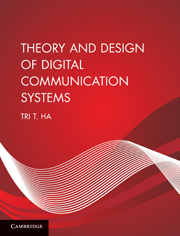Book contents
- Frontmatter
- Contents
- Preface
- Acknowledgements
- List of symbols
- List of abbreviations
- 1 Introduction
- 2 Deterministic signal analysis
- 3 Random signal analysis
- 4 Information theory and channel coding
- 5 Communication link analysis
- 6 Modulation
- 7 Demodulation
- 8 Spread spectrum
- 9 Intersymbol interference and equalization
- 10 Fading channels
- Index
- References
7 - Demodulation
Published online by Cambridge University Press: 05 June 2012
- Frontmatter
- Contents
- Preface
- Acknowledgements
- List of symbols
- List of abbreviations
- 1 Introduction
- 2 Deterministic signal analysis
- 3 Random signal analysis
- 4 Information theory and channel coding
- 5 Communication link analysis
- 6 Modulation
- 7 Demodulation
- 8 Spread spectrum
- 9 Intersymbol interference and equalization
- 10 Fading channels
- Index
- References
Summary
Introduction
The purpose of digital demodulation is to recover the information (bits, symbols) carried by the digitally modulated signals. This process can be achieved via coherent or noncoherent demodulation. The former requires a local reference carrier to be matched exactly in frequency and phase to the received signal. The latter requires only a match in frequency. Both types of demodulation involve two steps. In the first step, a signal processor is employed to convert the received signal that represents a bit (binary modulation) or a symbol (M-ary modulation) into a decision sample at maximum signal-to-noise ratio for the case of coherent demodulation. For noncoherent demodulation, the signal processor converts the received signal into a nonnegative decision sample independent of its unknown initial phase, which is cleverly discarded. Since the phase information is not employed, a loss in the signal-to-noise ratio for the decision sample results. The coherent signal processors are the matched filter and the correlator, both are equivalent at the time the decision sample is taken. The noncoherent signal processors are the matched filter-envelope detector (also known as noncoherent matched filter) and the quadrature correlator-square law detector (also known as noncoherent correlator), both are also equivalent at the time the decision sample is obtained. Binary demodulation employs one or two signal processors depending on the type of modulation.
Information
- Type
- Chapter
- Information
- Theory and Design of Digital Communication Systems , pp. 305 - 431Publisher: Cambridge University PressPrint publication year: 2010
